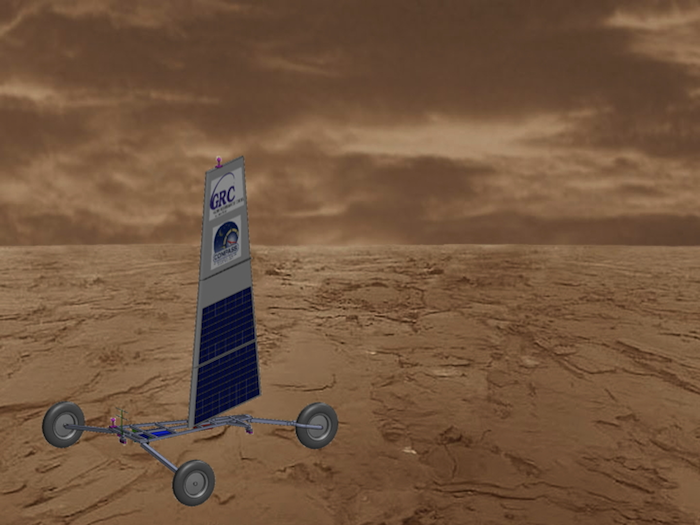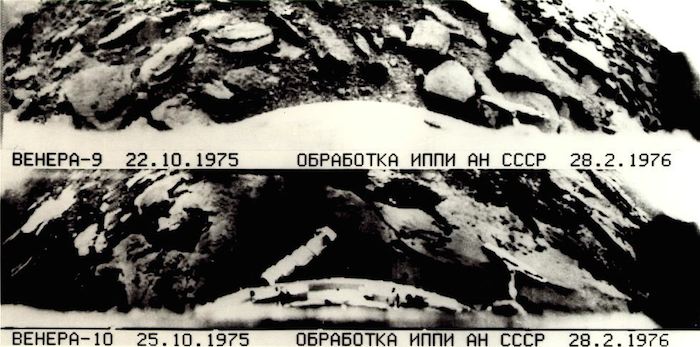.

NASA continues working towards a Venus landsail surface rover that could see launch as early as 2023 and mark the first time in a generation that any probe has landed on the planet’s hot, rocky surface. After a five month journey from Earth, the lander-rover — about the size of a windsurfing board — would begin a nominal 50-day surface mission.
If funded, NASA would launch this landsail “Zephyr” rover as a $400 million Discovery class mission with a coupled orbiter and lander. Once safely in Venus orbit, the rover-lander would detach for its journey through the planet’s thick atmosphere. Following an upright wheels-down landing, pyrotechnics would then cut the rover loose to explore the surface.
Loaded with some 50 pounds of science equipment, the landsail rover would move about courtesy of a 26-foot airfoil sail.
“The rover’s “sail” is actually rigid, like a vertical wing with solar cells on its surface,” Geoffrey Landis, the rover’s study scientist and a physicist at NASA Glenn Research Center, told me. “But under Venus conditions these cells are very inefficient.”In fact, humanity’s lengthy absence from Venus’ surface has not been due to a lack of interest in what has often been termed the forgotten planet. After all, Venus lies closer to us than Mars , but its hostile surface environment inherently comes with Herculean technical challenges.
The planet’s surface pressures are 92 times that of Earth with surface temperatures averaging 450 Celsius (842 F). That’s more than twice as hot as the average household oven. However, days on Venus are akin to life under the most menacing cloud cover here on Earth — only one percent of the Sun’s total solar output makes it to the surface.
NASA notes that the Venus’ surface has thus far only been visited by stationary Soviet and American probes, none of which were able to operate for more than a couple of hours on the surface.
What sort of landing site would the Zephyr need?
“We want to find a largely flat landing site that looks more like an asphalt parking lot and less like a sand trap,” said Landis.
.

Surface of Venus as imaged by Venera 9 (top) and Venera 10 (bottom).
Credit: USSR / Preserved by the NASA National Space Science Data Center
-
The old Soviet Venera 10 landing site at the foot of Venus’ Theia Mons shield volcano looks just perfect, says Landis. He notes that the site — not far from Venus’ equator in the planet’s northwestern quadrant, is very flat with some wind. With Venus’ superdense atmosphere, however, wind speeds of only 2 miles per hour should be sufficient to propel the rover up to a hundred yards a day; or about mile over the course of the mission.
The estimated 400-pound landsail rover’s science package would be bare-bones. Think a high-resolution color panoramic camera; weather instrumentation; a robotic arm and drill with an alpha particle x-ray spectrometer to determine chemical compositions; and radio communications technology which would use the mission orbiter as a communications relay back to NASA’s Deep Space Network.
“When Venus is at its closest to Earth, the communications time-lag from Venus and back is a little over four minutes,” said Landis. “That’s too long to control from Earth in real time, so we will have the rover parked with the sail slack while the ground controllers examine the terrain and decide the next target.”
Once ground-control’s commands have been sent to the orbiter, says Landis, the orbiter would then relay the commands to the rover.
As for science from the surface?
Planetary scientists think that much of Venus is very geologically-young geologically due to some sort of inexplicable catastrophic overturning that transfers heat from the planet’s interior onto its surface. As a result, the planet appears to be rife with recent lava flows.
Zephyr may find answers to such quandaries if it’s funded and reaches the surface. Landis and colleagues hope to garner follow-on funding for the mission later this year.
Meanwhile, Landis and his team continue to grapple with new silicon carbide and gallium nitride semiconductor technology that essentially did not exist a decade ago in order to enable the rover’s electronics to function under high pressures and in such high temperatures.
“Without the high temperature electronics,” said Landis, “we wouldn’t even be able to think about this.”
Quelle: Forbes4527 Views
